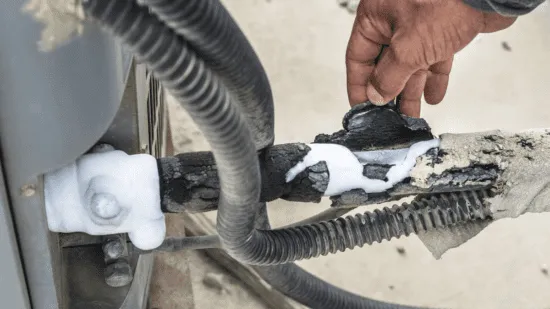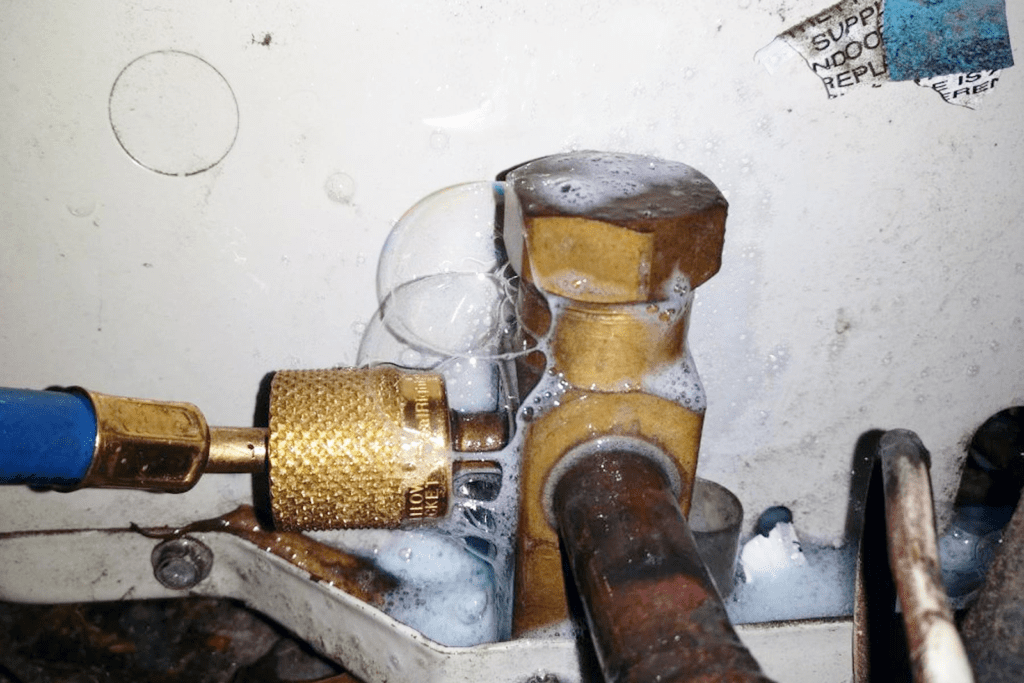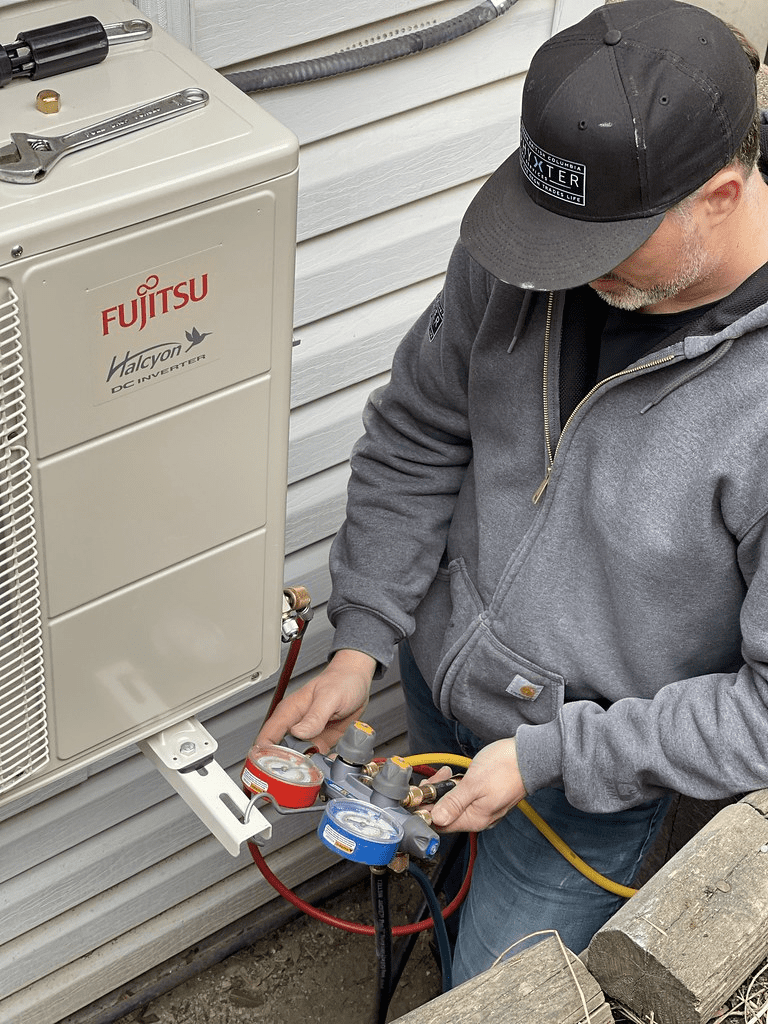So your AC has decided to take a summer vacation just when you need it most. It’s blowing warm air, running like it’s training for a marathon, and your home feels more like a sauna than a sanctuary. Odds are, you might be dealing with a refrigerant leak—aka the drama queen of HVAC issues.
Refrigerant is your system’s secret sauce—the chilled-out chemical that keeps things cool. When it leaks out, your poor AC can’t keep up, and you’re left sweating. Spotting a leak early is the difference between a quick fix and a budget-busting repair. Let’s break it down, from tell-tale signs to DIY tips and when to call in the pros.

Contents
Signs You Might Have a Refrigerant Leak
Refrigerant is basically the iced coffee of your AC—without it, nothing productive happens. Leaks can be sneaky and slow, creeping in until suddenly your AC’s working overtime and getting nowhere.
Here’s what to look out for:
- Weak or warm airflow from the vents: Cold air has left the chat. If your AC feels like it’s exhaling rather than cooling, the refrigerant may be MIA.
- Hissing or bubbling noises: That’s not your AC whispering sweet nothings—it’s likely a leak. Hissing = small leak, bubbling = bigger mess.
- Ice buildup on the evaporator coil or refrigerant lines: When refrigerant dips too low, pressure plummets and things start to freeze. Not in a good way.
- Cooling cycles that go on forever: Your AC is trying its best with what little refrigerant it has. Bless its heart.
- Higher-than-usual utility bills: You’re not imagining it. Your AC is guzzling energy just to keep up.
- Humidity creeping up indoors: Your AC also plays dehumidifier, so a sticky house is a red flag.
Safety First (Because This Isn’t a DIY Spa Day
Let’s get one thing straight: air conditioning systems are no joke. High voltage, pressurized gas, and chemicals that can literally freeze-burn your skin are not ideal DIY playmates.
Start by flipping that power switch OFF. We’re not here for surprise zaps or flying fan blades. Next, suit up with:
- Safety glasses (yes, even if they mess with your brows)
- Sturdy gloves
- A long-sleeved shirt you don’t mind sacrificing to the HVAC gods
And here’s the big one: Don’t go messing with refrigerant directly. In fact, you are legally prohibited from directly handling refrigerant in many countries, particularly in the West. Leave the heavy lifting to the professionals—especially if you don’t want to toast your system or your warranty. While it is good to be aware of potential leaks and these can be checked for, avoid dealing with the refrigerant itself.
Only certified HVAC technicians are allowed to:
- handle or recharge refrigerants;
- open or service sealed refrigerant components;
- use professional-grade leak detection equipment like nitrogen testing or recovery machines.
On top of not causing yourself harm, it’s also harmful to the environment. Improperly handling it can seriously damage your system and void your warranty as well. So at this stage, the best option is certainly to contract a professional company like ACRepair NYC.
Methods to Check for Refrigerant Leaks
Now, onto the fun part: detecting the leak. Some of these methods are totally homeowner-friendly. Others? Best left to someone with a badge and a toolbox.

Visual Inspection
A fluorescent dye is injected into the AC system. As the refrigerant circulates, any leaks will leave behind traces of the glowing dye. After that, a UV light is used to inspect refrigerant lines, coils, and fittings. Leaks will glow brightly revealing the exact location.
Soap Bubble Test
This one’s a classic. Mix some dish soap and water, spray it on the suspected leak areas—joints, valves, connections. See bubbles? Congrats, you’ve found the leaky villain.
Side note: this trick is as satisfying as watching pancake batter bubble—just less tasty.
Fancy Stuff (for the Semi-Pro DIYer)
- Electronic Leak Detectors: These sniff out refrigerant like a bloodhound. Great for those hidden spots you can’t quite see.
- UV Dye Test: The system gets injected with a glowing dye (no, not the kind you use on Easter eggs), and a UV light reveals the leak like magic.
Pro-Level Only
Pressure Testing: Sounds intense? It is. Certified techs will pressurize the system with nitrogen and monitor it like a hawk. It’s ultra-precise—but also ultra-off-limits unless you’re HVAC certified.

What to Do if You Find a Leak
So you’ve found the culprit—now what? While sealants may promise a quick patch job, they’re the duct tape of the HVAC world. Temporary. Messy. Potentially warranty-wrecking.
Avoid:
- Gunky sealants that clog things up
- Topping off refrigerant without a repair
- Waiting until it gets really bad (don’t be that person)
The right fix is repairing or replacing the faulty part. Full stop. Then—and only then—should refrigerant be refilled.
Preventative Maintenance Tip
Here’s how to keep your AC happy, your home chill, and your bills a little less shocking:
- Stick to a maintenance schedule: Twice a year is the sweet spot. Get a pro to peek under the hood before summer and winter.
- Clean your coils: Dust, dirt, and pet fur? Your coils hate it. Clean them annually or more if your golden retriever sheds like it’s his job.
- Keep air flowing freely: Swap those filters every 1–3 months. Clogged filters = grumpy AC and higher bills.
Want to keep your home breezy and your wallet full? Start with these simple steps—and if you’re hungry after all this HVAC talk, treat yourself to something just as cool, like this easy ramen stir fry recipe. You earned it.
